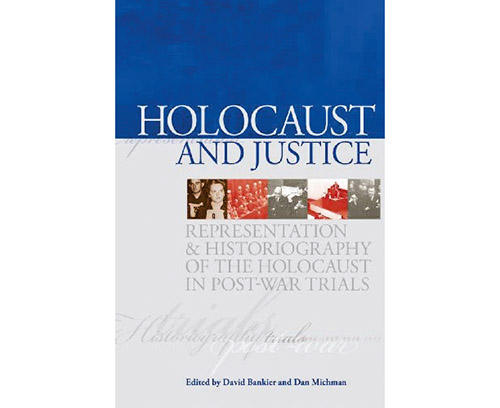
“Holocaust and Justice: Representation and Historiography of the Holocaust in Post-War Trials,” by David Bankier and Dan Michman, Eds. Yad Vashem Publications. 2010. ISBN:
978-965-308-353-0.
A popular misconception about the 13 trials conducted by the International Military Tribunal in Germany between 1945 and 1949 is that the Holocaust was a primary subject of the prosecution. The Nuremberg Trials were the “first time in history, political and military leaders of a country were tried and indicted for crimes they had committed during wartime,” Israeli historians David Bankier and Dan Michman note. As Lawrence Douglas, an American law professor, points out in this volume, the idea that those who commit mass atrocities must be held accountable in criminal courts—whether domestic, international or in some combination of the two—is now universally accepted.
For the unprecedented events, an international tribunal was convened. The creation of these unique legal proceedings raises a number of questions: What was the background that enabled this development, and what impact did these trials have on the postwar world—on international law, on the prosecution of war crimes, on historiography and collective memory, on coping with the past, on media coverage of the trials, on the cinematic image of World War II and the Holocaust? Significantly, the German attempt to annihilate European Jews was not the central focus of the trials, although the “very facts of the persecution of the Jews and their wholesale murder were explicitly mentioned in several instances and implicitly in many,” Bankier and Michman conclude.
To commemorate the 60th anniversary of the end of the first Nuremberg Trials, the Yad Vashem Institute for Holocaust Research held an international conference focusing on the issues the trials raised and selected a number of papers presented at the conference by scholars from Great Britain, France, Germany, Poland, Belgium, Israel, the U.S. and Canada for this extremely important volume.
The book is divided into three sections. The first deals with Nuremberg Trials—their background, the environment in which they transpired, their judicial character and their long-range influence in the immediate years after the war. The second section focuses on the trials of German war criminals conducted by German courts, and how they were covered by the media and the way in which the Holocaust was portrayed by them.The last section examines the trials in countries Germany occupied during the war: Belgium, France, the Soviet Union, Poland and Italy, in an effort to understand the historical and legal background and the long-term influence on memory of the and how the Holocaust is being represented.
Donald Bloxham, an English historian, discuses the “other side” of the trials: “… the sentence reviews for, and amnesties and premature releases of those convicted of offenses related to Nazi rule.” This is an area that received scant attention, which Bloxham asserts, undermines one of the most critical justifications for the trial—”imposing the rule of law on naked power relations.”
Germany “effectively placed a limit on the extent of the reckoning” by viewing the trial as “a slur on the nation.” In purging its past, Germans had to consider two issues. They were prepared to remove Nazi symbols and some of those involved in the regime from their positions. At the same time, the Germans sought to prevent alienating sizable segments of the German public or the “administrative elites” who might have been complicit in committing war crimes, and were required “to ensure stability and viability to the new polity.” Consequently, this became a key consideration as to whom would be brought to judgment.
In a different work, historian Omer Bartov adds another dimension to the situation the Germans faced after the war. When the soldiers returned to their homes, they took with them “the images and horrors of the war, the perverted morality which had formed its basis, and the distorted perception which made living through it bearable.” Each family had at least one soldier who served at the front. These young men then went on to become laborers, bureaucrats, lawyers, physicians, psychologists, politicians, teachers, bankers, judges, professors and journalists. The murder of the 6 million was perceived as simply just another facet of the war, not something especially exceptional to Nazi Germany’s very distinctive war.
Since many more Germans experienced the strategic bombing raids and the occupation of their land than had witnessed the extermination camps, they are the memories that remained embedded in their minds. Thus, the German people were no longer directly connected with the destruction of European Jewry and became “something that had not been executed by them, but in their name.” Defeat had transformed the Germans into victims. And victims cannot be held accountable.
Dr. Alex Grobman is the senior resident scholar at the John C. Danforth Society and a member of the Council of Scholars for Peace in the Middle East.










